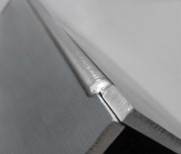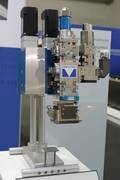- Contact 0870 350 7767
- |
- Advertise
Laser Cladding Project at Tata Steel
 News and PR from Laser Trader Ltd - Published 07 April 2014
Laser Cladding article describing a project undertaken with Tata Steel to increase the lifetime of components in the Steel Industry using a Precitec YC52 Cladding Head
News and PR from Laser Trader Ltd - Published 07 April 2014
Laser Cladding article describing a project undertaken with Tata Steel to increase the lifetime of components in the Steel Industry using a Precitec YC52 Cladding HeadMSS-welded alloys generally have good wear and corrosion characteristics; however, they are not suitable for severe metal-on-metal abrasion, and they also lose their mechanical and corrosive properties at high temperatures. Arc-welded MSS alloys also suffer from weld sensitization in grain boundaries in the heat affected zones (HAZs) where chromium carbides are precipitated, leaving the surrounding areas depleted in chromium. These areas are therefore susceptible to localized corrosion.
Thermally sprayed coatings are also in widespread use throughout the steel industry because of their flexibility in the types of alloys and metal matrix composites (MMCs) that can be applied. However, their mechanically bonded interfaces have relatively low strength (unless post spray fusing is employed), limiting their practical use in an environment with very heavy impacts.
In 2009, a system was built in Port Talbot, South Wales, UK, in an attempt to develop laser cladding for coating critical works components to increase their service lifetime (FIGURE 1). In the rolling mills of the steel industry, different rolls of 0.3 to 3.5 meters in length are needed. Laser clad coatings have been proven to extend the lifetime of components by up to 6×.
FIGURE 2. The YC52 cladding head with a coaxial nozzle.
Since the installation of the laser cladding system in Port Talbot, the process has been developed and numerous nickel cobalt and iron-based-material alloys have been assessed in terms of microstructure, mechanical properties, and wear and corrosion resistance. Detailed process development is required to tailor the coating properties for each application within the steel works.
The initial results from line trials were extremely encouraging: components that were laser clad obtained unprecedented wear and corrosion performance. As such, it was decided to build a production machine to cope with the anticipated demand.
Other announcements from Laser Trader Ltd
-
Laser Trader On LinkedIn
If you haven't already seen us, be sure to check out the Laser Trader Ltd page on LinkedIn, the networking site for professionals.
17 Feb 2020
-
Service and Support page now live
As well as supplying equipment we like to take care of our customers through the entire product lifecycle, as such we offer excellent after sales support.
17 Feb 2020
-
Laser Trader is expanding
The 2018/19 year has been a busy one for Laser Trader. We have added two new engineers to our office, and moved to a bigger office twice this year to fit us all in!
17 Feb 2020
-
Laser Trader Sponsors ILAS 2019
Laser Trader is proud to announce it's sponsorship of the 2019 Industrial Laser Appliactions Synposium.
17 Feb 2020
-
Precitec Scan Tracker gives impeccable laser welded seams
The use of a the Precitec ScanTracker, permits conduction welding, with scan function, of thick-walled aluminum components.
07 Apr 2014
-
Rapid and accurate cutting and welding
Wherever the machining accuracy of robotic arms and gantry systems does not suffice, the FormCutter is employed as an additional axis system.
07 Apr 2014









